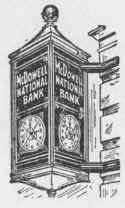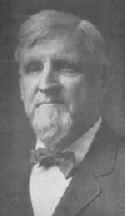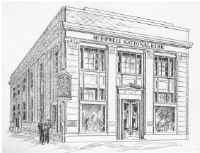| Sharon | |||
Sharon's Yesterdays & Tomorrow An Outline of the Growth of Sharon and its Industries.... and a History of the McDowell National Bank, June 1935
|
|||
|
|
History of the McDowell National Bank
Shortly alter Alex
McDowell had established his banking business in 1872, the country
was visited by a depression. One cause assigned to the 1873 panic was “over
production”. At that time there were in the Shenango Valley 32 blast
furnaces, all idle. A new furnace, the first steel jacketed furnace, had
just been built. Only a short time before, iron ore, for the first time,
had been melted by using coke for fuel. The chief product of the local mills was iron
rails, and the principal market was in the Northwest. Steel rails had but
lately been introduced. They proved so efficient that no more iron rails
were made in Sharon after this panic. It was necessary to find new
uses for the iron produced here in order to keep the community
growing. The present day changes in steel making may
compel another shift in Shenango Valley’s industrial setup, but a
community that has the many advantages of this Valley is bound to attract
industry. In 1884 the community was visited by a great
panic caused by unwise investment and reckless finance of city
bankers. Again in 1893 the bank had to face a test that
taxed banks almost to the limit. Credit was at a low ebb. There were 156
railroads in the hands of receivers, including the Erie, the Northern
Pacific and the Union Pacific. If names of railroads were changed,
conditions in this field would have been almost identical with those of
today. During tills period. unemployed were so numerous
that a man known as General Coxev of
Mansfield, O., organized an arm of unemployed and marched with them to
Washington. In 1903 another slump in business occurred. It was
described by J. P. Morgan as being due to
“Undigested securities,” which had reference to the amount of new
securities that had been brought out by ill advised financing, mostly in
cities. The securities were not purchased by the public. Again in 1907 we had a short-lived money panic,
chiefly centered in large cities where people became frightened because
they thought they could not get any money. This particular panic had a
great deal to do with the establishment of the Federal Reserve Banks. Business was at a low ebb at the beginning of
the World War in 1913. The falling off of investment values in 1921 caused
great distress and many failures. Big banking business again became
frightened and called loans. In all of the records of these depressions there
does not appear any sound reason to believe that the concentration of bank
control in large centers, through a system of branch banking, would be of
any benefit to the country as a whole. On the contrary, records indicate
that the results would be adverse to the country’s welfare.
|
McDowell National Bank Clock
Alexander McDowell
The New Home of the McDowell National Bank, 1935
|
|



